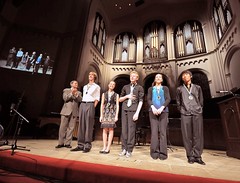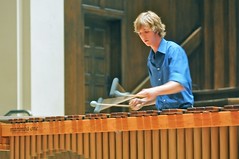Show 223: Listening Guide
 This week’s From the Top broadcast (Show 223) was taped at the First Baptist Church in Abilene, TX on Tuesday November 16, 2010. We asked our performers to tell us about the music they performed on the show:
This week’s From the Top broadcast (Show 223) was taped at the First Baptist Church in Abilene, TX on Tuesday November 16, 2010. We asked our performers to tell us about the music they performed on the show:
Karen Christianson, 15, organ
Everyone Dance
By: Calvin Hampton
“Everyone Dance” by the American composer Calvin Hampton is a spirited, contemporary work that shows off a completely different side of organ literature than what most people think of when they think “organ”. The recurring chromatic passages, using all the notes of an octave in stepwise motion, are supposed to symbolize inclusiveness of all people through music & dancing. I have never learned anything quite like this piece before, and it is really fun to play because of the interesting rhythmic patterns. I even feel like dancing sometimes when I play it; my dad makes fun of me for bobbing my head to the music! I guess I just get really into it!
This piece is unique in that it is a very contemporary work. The most important and challenging thing while playing this piece is to capture the audience’s attention, because with this kind of piece, the listener will either love it or hate it. The organist must properly convey the rhythmic patterns in the right hand against the steady ostinato pattern in the left hand. This is my classmates’ favorite piece because they like the catchy tune and how it builds up to a dramatic ending. In fact, I’ve caught a couple people singing the tune after I’ve played it at school! I also think that the pulsating 8th notes throughout the piece in the left hand are somewhat reminiscent of modern popular music so kids can relate to this piece.
Post Show Reflection: It was an amazing experience and a huge honor to be a part of this show. The staff was incredible, so nice and welcoming, and made the experience so much more relaxed and fun for me than I had expected it to be before I came. The audience was really accepting and appreciative of us while we were on stage and also afterwards at the reception. It was a great organ to work with and I am really pleased with the way “Everyone Dance” sounded on it!
Taekguk Mun, 16, cello
Pezzo Capriccioso,Op.62
By: Pyotr IIIyich Tchaikovsky
This piece has two main opposing kinds of emotions, one being very depressing and painful and the other being much playful and jolly. The very beginning, until the cello comes back in after the piano solo, which I would like to call the ”overture” to the piece rather than an introduction, opens up the piece with this heavy, furious, yet painful melody/feeling. After the “overture,” the cello comes in with the main melody of the piece, and it feels very serene and depressing. However, when the fast section begins after the long B and Bb, it gets just so fun to listen to and also to play! Whenever I play the fast section, I always think of a mouse running away from a cat, just like a typical Tom and Jerry episode. The slow melody comes back with a little bit of variations after those really high trills and the glissando transition, then eventually goes back to the fast part, but in different key this time. The piece ends with the “impossible” high B, as I and my friends call it. =)
This piece really requires a sufficient amount of concentration on phrasing and color of the sound, especially for the slow melody. Although it is beautiful, there are tons of repetitions of the melody, and therefore, what makes this piece really enjoyable and even more beautiful is to make phrases not sound the same all the time and really have varieties in the sound and characteristics.
Halle Puckett, 12, piano
Etude in F major,Op. 72 No.6
By: Moritz Moszkowski
Spanish Dance:
When I play this piece, the intro makes me think of a dark, scary forest. But then as the theme begins, I think of a circus falling out of the sky and landing right in front of me as the scary, dark forest turns into a happy circus setting! Dancers with colorful dresses and castanets are twirling all around me.
When I play the Spanish Dance, I want the audience to jump out of their seats and spin and twirl all around, dancing their hearts out!
Etude:
One place I performed this piece was at a restaurant in Ohio called Bongiorno’s, where my Grandpa played jazz piano some nights. Even though this isn’t the type of piece you would hear in a restaurant where you listen to jazz piano, my grandpa insisted I play it. So I did, even though it was on an electric keyboard and I hate any kind of “electric” instrument! But I’m so glad I played it because everyone really enjoyed my Moszkowski Etude in F major non-jazz piece on an electric piano that night!!!!
The hardest thing to nail for me is not rushing. Since it is an extremely fast moving piece. I tend to get excited and speed up! This piece is kind of like me in a way. I love to sprint! When I’m racing somebody, I start to get really excited and anxious and go faster and faster! If I do this in my piece it’s not good…
 Austin Allen, 18, marimba
Austin Allen, 18, marimba
llijas
By Nebojsa Zivkovic
I love both the beginning and the end of Ilidas. They are extremely emotional and the end of the piece actually has the word “dying” written as a music expression. The piece is almost like a birth, life, and death story. It starts out beautiful and emotional, possibly like the break of dawn or the brith of a baby, the middle is lively and energetic, and the end becomes sad, slow, emotional, and it finally dies out.
This piece is much more varying in its styles than a lot of other pieces I have played in the past. It has a depth of emotion as well as a light, springy, energy to it. Ilijas is a town is Russia and although it is hard to describe this town through music, slowing the different aspects, the different feels and musical developments helps get the idea across.
Post Show Reflection: Playing on From the Top was an incredible experience. Everyone on the show was so nice and put together which really made the entire experience enjoyable. They all seemed to have so much fun working with Christopher O’Riley, the performers, as well as each other. I think all the performers had a great time and we were also so appreciative of the Abilene community who worker together and made this performance fun, smooth, and easy. The housing accommodations were incredible and getting to know this beautiful little country town was truly great. Thanks to everybody.
Eric Fricke, 18, organ
Howl’s Moving Castle
By Joe Hisaishi
This piece is a musical depiction of the dramatic action of the movie “Howl’s Moving Castle.” Starting with the mysterious castle in the mist, the piece portrays the adventure of a young girl, whom the main theme represents, trying to break a curse that has made her a 90-year-old woman. It is only appropriate that the piece is a waltz, as the waltz, being a romantic interaction of two people and a surviving memory of 19th century Germanic culture, personifies the plot and the setting.
This waltz is a rare example of cheerful music in a minor key, perhaps due to its insistent cadences on a major instead of a minor chord. Playing this piece challenges one to capture the cinematic sweep and keep the gracefulness of the waltz while achieving the constantly changing colors and maintaining numerous voices, i.e., the statement of the theme after the key change requires all four keyboards of the organ to be played at once by the using the thumbs of each hand on a different keyboard than the other fingers.


